by Lisa Cooke | Jul 13, 2015 | 01 What's New, African-American, Ancestry, Australian, British, Canadian, Genealogy Gems Podcast, History, Memory Lane, Research Skills, United States
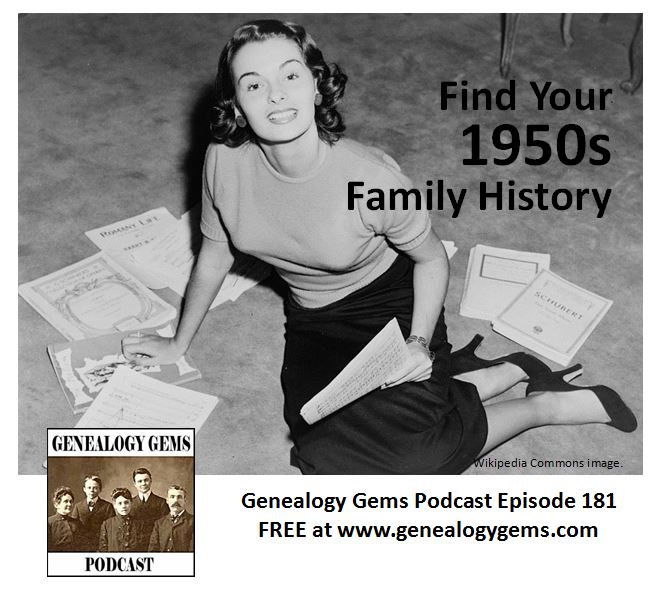 Sock hops. Drive-ins. Juke boxes. Fuzzy dice. Letterman jackets. Poodle skirts, bobby socks and saddle shoes. Do the 1950s come to mind? They will when you listen to the newly-published Genealogy Gems podcast, episode 181!
Sock hops. Drive-ins. Juke boxes. Fuzzy dice. Letterman jackets. Poodle skirts, bobby socks and saddle shoes. Do the 1950s come to mind? They will when you listen to the newly-published Genealogy Gems podcast, episode 181!
The 1950s are a great era to research your family history, but it may not seem easy at first. Federal censuses (1950 in the U.S. and 1951 in Canada, the U.K. and Australia) are privacy-restricted, and so are many vital records.
In this episode, I’ll inspire you with several very FUN approaches to learning about your family history during this time period. I’ll also give you some tips and factoids about those blacked-out 1950s censuses–including which census had women up in arms because the government asked them to be more honest about their ages!
There’s plenty of news in this episode, too, from a new Google innovation to two new record collections online that fill in some holes in U.S. documentary history (military and African-American). I’ll read some mail from YOU about the new Ancestry site and family history blogging and share some helpful resources. And we announce the latest Genealogy Gems Book Club pick: listen or click here to learn more about that!
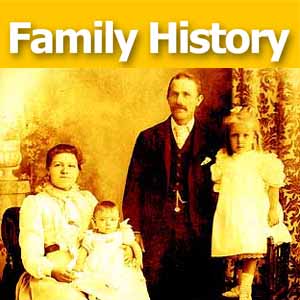 Click here to access Genealogy Gems podcast episode 181. Love this and looking for more? Click here to access the FULL archive of FREE Genealogy Gems podcast episodes. If you love the podcast format but are looking for a more step
Click here to access Genealogy Gems podcast episode 181. Love this and looking for more? Click here to access the FULL archive of FREE Genealogy Gems podcast episodes. If you love the podcast format but are looking for a more step -by-step approach to family history, check out our free Family History Made Easy podcast series.
-by-step approach to family history, check out our free Family History Made Easy podcast series.
by Lisa Cooke | Apr 23, 2015 | 01 What's New, Census, United States
The 1950 federal U.S. census will not be released to the public until April 2022. Are you as excited about that as I am? This census will provide volumes of new information about our families and their lives.
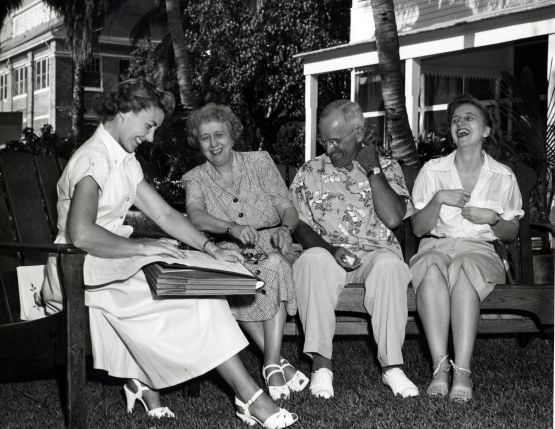
An enumerator interviews President Truman and the First Family for the 1950 Census. Image from www.census.gov.
Answers to Your Questions about the 1950 Census
Here are answers to four of the common questions we receive about the 1950 census:
What will I be able to learn from the 1950 census?
With each decade the federal government has asked more detailed questions. The information collected has expanded our understanding of the families, their backgrounds, and their lifestyle.
Here’s what the front page of the 1950 Census of Population and Housing form looked like:
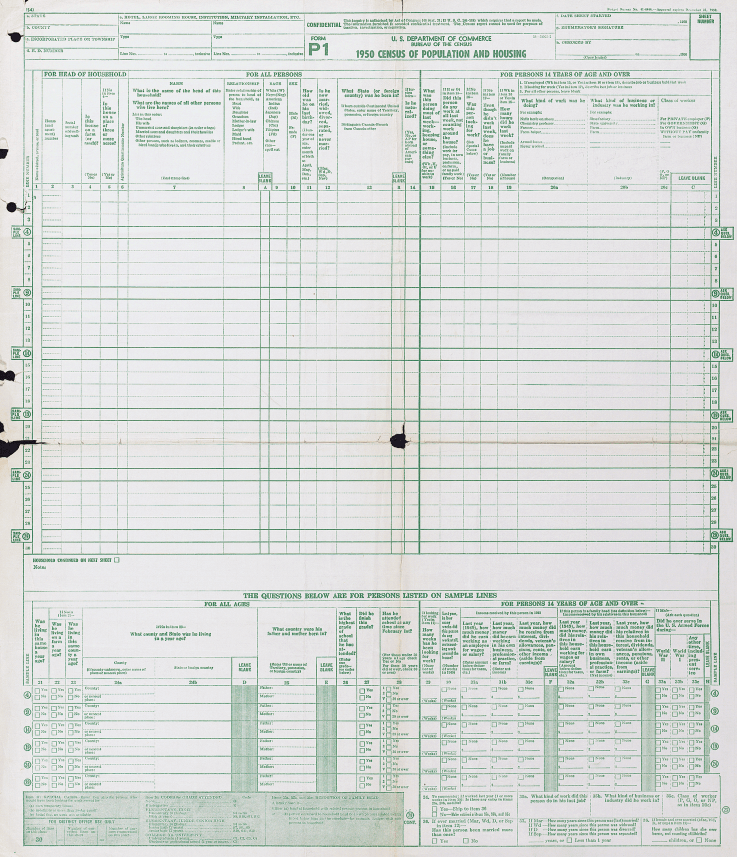
As you can see there is a wealth of information that will be of interest to family historians.
The back side of the form may not be as familiar to you, but it too collected a vast amount of fascinating data:
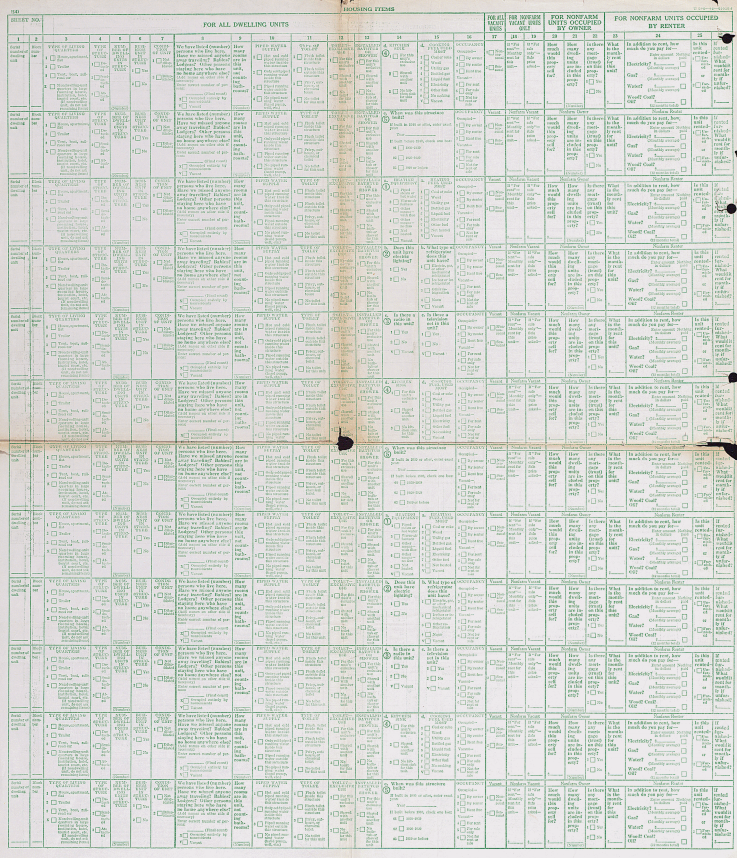
Let’s take a closer look at one of the rows:

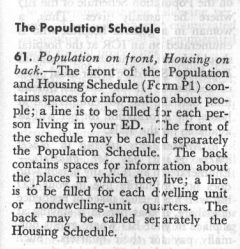
Instructions regarding the front and back of the Population and Housing Schedule Form P1
As you can see the back side of the form is focused on housing. Here you’ll find answers to questions about:
- Type of Living Quarters
- Type of Structure
- Whether a business was run from the house
- The condition of the building
- If there are any inhabitants who may be somewhere else at the time the census was taken
- How many rooms
- Type of water, toilet and shower / bath facilities
- Kitchen and cooking facilities
- Occupancy
- Financial and rental arrangements
Additional questions were not asked of all, but rather were asked on a rotating basis. These centered around additional features of the home such as radio, television, cooking fuel, refrigeration, electricity and the year the home was built.
Are enumerator instructions available for the 1950 census?
The instructions issued to enumerators can provide you with further insight into the records themselves. It can also clarify the meaning of marks and numbers you may find on the documents.
And yes, the US Census Bureau has indeed published the instructions for the 1950 census on their website here. According to their site:
“During the 1950 census, approximately 143,000 enumerators canvassed households in the United States, territories of Alaska and Hawaii, American Samoa, the Canal Zone, Guam, Puerto Rico, the Virgin Islands, and some of the smaller island territories. The U.S. Census Bureau also enumerated Americans living abroad for the first time in 1950. Provisions were made to count members of the armed forces, crews of vessels, and employees of the United States government living in foreign countries, along with any members of their families also abroad.”

Also on that web page you’ll find instructions for the following years: 1790, 1850, 1860, 1870, 1890, 1900, 1910, 1920, 1930, and 1940.
Can I request individual census entry look-ups?
Yes, you may apply to receive copies of individual census entries from 1950-2010 for yourself or immediate relatives. It’s not cheap—it’s $65 per person, per census year. (Check the website for current pricing.) But if you’re having research trouble you think would be answered by a census entry, it might be worth it. Click here to learn buy lithium medication online more about the “Age Search Service” offered through the Census Bureau.
Is there a 1950 census substitute database?
Yes, Ancestry has one. You might find it a little gimmicky, because it’s just taken from their city directory collection from the mid-1940s to the mid-1950s. But it’s a good starting point to target your U.S. ancestors living during that time period. The annual listings in city directories can help you track families from year to year.
More Resources
Your 1950s family history may appear in other records as well, and I’ve got some tips to help you in your search. Click here to learn more!
by Lisa Cooke | Jun 18, 2013 | 01 What's New, Census, Records & databases
 Hands up, who wants to help prep the 1950 U.S. census for us all to explore?
Hands up, who wants to help prep the 1950 U.S. census for us all to explore?
The 1950 census won’t be released to the public for seven more years, but it took just longer than that to create the locational tools that millions of researchers have used to find their families on the 1940 census.
The dynamic duo of Steve Morse and Joel Weintraub, who produced the locational tools for the 1940 census on the Morse One-Step site, are recruiting 200+ volunteers to help transcribe enumeration district definitions and create urban area street indexes for the 1950 census.
Their “job description” for these volunteers sounds really meaty and hands-on: “These projects aren’t for everybody. Volunteers should have basic computer skills, typing skills, have access to the Internet, be detail people but not perfectionists, be independent workers and able to follow instructions, be patient enough to handle large amounts of information, and be comfortable with projects that may take weeks or months, not hours, to accomplish. You should be able to handle and manipulate images (jpgs) of maps and Enumeration District (ED) definition scans. A large computer monitor would be desirable but not essential. We will provide instructions for carrying out the work, and a place to ask questions. Volunteers may use some free programs to help speed up the entry process. We expect volunteers to make steady progress on their assignments, and we have the luxury of time right now to do it well.”
Learn more about the project here, and try the 1940 One-Step locational tools here.
 Sock hops. Drive-ins. Juke boxes. Fuzzy dice. Letterman jackets. Poodle skirts, bobby socks and saddle shoes. Do the 1950s come to mind? They will when you listen to the newly-published Genealogy Gems podcast, episode 181!
Sock hops. Drive-ins. Juke boxes. Fuzzy dice. Letterman jackets. Poodle skirts, bobby socks and saddle shoes. Do the 1950s come to mind? They will when you listen to the newly-published Genealogy Gems podcast, episode 181! Click here to access Genealogy Gems podcast episode 181. Love this and looking for more? Click here to access the FULL archive of FREE Genealogy Gems podcast episodes. If you love the podcast format but are looking for a more step
Click here to access Genealogy Gems podcast episode 181. Love this and looking for more? Click here to access the FULL archive of FREE Genealogy Gems podcast episodes. If you love the podcast format but are looking for a more step -by-step approach to family history, check out our free Family History Made Easy podcast series.
-by-step approach to family history, check out our free Family History Made Easy podcast series.










